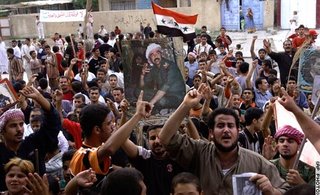Chapter 7's notes for you slow writers
Since 1st and 2nd block Geo has a new student teacher, and some of us (myself included) are incredibly slow writers. So, for your educational enjoyment, I give to you the first set of Chapter 7's notes.Chapter 7: Southwest Asia & North Africa
(Fig. 7.1)
Introduction
– SW Asia and N Africa extend 4,000 miles
– This region is a culture hearth – a region that witnesses many cultural innovations that subsequently diffuse to other parts of world
– Development of petroleum industry has had large impact on the region
OPEC (Organization of Petroleum Exporting Countries) – member countries profoundly influence global prices and production targets for petroleum
– Islamic fundamentalism – this aspect of Islam that advocates return to more traditional practices, calls for merger of civil and religious authority, and challenges encroachment of global popular culture
Environmental Geography: Life in a Fragile World
– A long history of human settlement in SW Asia and N Africa has left its mark on the environment
Regional Landforms
– SW Asia is more mountainous than N Africa
– North Africa
– Maghreb (“West Island”) –includes Morocco, Algeria, and Tunisia; dominated by the Atlas Mountains
– Southwest Asia
– Levant – eastern Mediterranean region of Southwest Asia has mountains and highlands
– Anatolia – peninsula of Turkey (“Asia Minor”) is a geologically active plateau
– Mesopotamia – in Iraq between the Tigris and Euphrates rivers
Physical Geography of Southwest Asia & North Africa (Fig. 7.4)
Patterns of Climate
– Complex climate region because of altitude and latitude
– Large portions of the region are arid
Deserts stretch from the Atlantic coast across Africa, through the Arabian Peninsula, and into central and eastern Iran
– Mediterranean climates in Atlas Mountains and the Levant coastline caused by altitude and latitude
Legacies of a Vulnerable Landscape
– Lengthy human settlement has led to environmental problems
– Deforestation and Overgrazing
– Human activities and natural conditions have reduced most of the forests to grass and scrub
– Caused by overgrazing, fires; vulnerable to fire
Climate Map of Southwest Asia & N Africa (Fig. 7.7)
Legacies of a Vulnerable Landscape (cont.)
– Salinization
– Buildup of toxic salts in the soil from centuries of irrigation
– Hundreds of thousands of acres of farmland degraded
– Managing Water
– Availability of water a problem throughout the region
– Qanat system – Iranian process of tapping into groundwater through a series of gently sloping tunnels
– Egypt built Aswan High Dam to store water, generate energy, but it has created environmental problems
– Libya’s “Great Man-made River” draws underground fossil water 600 miles to irrigate crops in the north of the country
– Hydropolitics – interplay of water resource issues and politics
Environmental Issues in SW Asia & N Africa (Fig. 7.10)
Population and Settlement: Patterns in an Arid Land
– Dry areas are scarcely settled, while moist lands may be overpopulated
The Geography of Population
– More than 400 million people in the region
– Physiological densities are among the highest on Earth
Physiological densities – a statistic that relates the number of people to the amount of arable land
– Two dominant population clusters:
Maghreb: moister areas of Atlas Mountains and coastal regions
Egypt’s Nile River valley: 70 million live within 10 miles of the river
Population Map of SW Asia & N Africa (Fig. 7.13)
Water and Life: Rural Settlement Patterns
– This region is an early hearth of agricultural domestication
Domestication – process in which plants and animals were purposefully selected and bred for their desirable characteristics; it began in this region 10,000 years ago
Fertile Crescent – ecologically diverse zone that stretches from Levant inland through the fertile hill country of northern Syria into Iraq
– Pastoral Nomadism
– Traditional form of subsistence agriculture in which practitioners depend on seasonal movement of livestock
Transhumance – seasonal movement of livestock from winter to summer pastures
– Oasis Life
– Areas where high groundwater or deep-water wells provide reliable moisture
Small agricultural settlements
Serve as trading centers as well
– Exotic rivers – a river that comes from a humid area and flows into a dry area that otherwise lacks streams, can support irrigation
Kibbutzes – collectively worked settlements that produce grain, vegetable, and orchard crops irrigated by the Jordan River and feeder canals
– The Challenge of Dryland Agriculture
– Depends on seasonal moisture (associated with Mediterranean regions)
– Includes tree crops, livestock, grains, and illegal hashish
Agricultural Regions of SW Asia & N Africa (Fig. 7.14)
Water and Life: Rural Settlement Patterns
– Many-Layered Landscapes: The Urban Imprint
– Some of the world’s oldest urban areas are in this region
– A Long Urban Legacy
– City life began in Mesopotamia (Eridu & Ur 3500 B.C.), and Egypt (Memphis & Thebes 3000 B.C.)
– Rise of trade centers around 2000 B.C.
– Centers of Islamic religious administration and education
Examples: Baghdad, Cairo
The original urban core of a traditional Islamic city is called a medina, has central mosque, bazaar
– Colonialism left European influence
Water and Life: Rural Settlement Patterns
– Signatures of Globalization
– Urban centers have become focal points of economic growth (Ex: Cairo, Algiers, Istanbul)
– Oil wealth has added modern element to traditional cities
– A Region on the Move
– Migration streams
Rural-to-urban migration
Migration of low-wage workers from other regions to SW Asia and N Africa
Migration of workers from the regions to other places (ex.: Turkish guestworkers to Germany)
Shifting Demographic Patterns
– Population growth rates vary within the region
– Women in Tunisia, Iran, and Turkey are having fewer children
Causes include delayed marriage, family planning initiatives, greater urbanization
– High rates of natural increase in West Bank, Gaza, and Libya
– Increasing population will strain cities, water supplies, public services
– Jobs will be needed for the people added to the population




